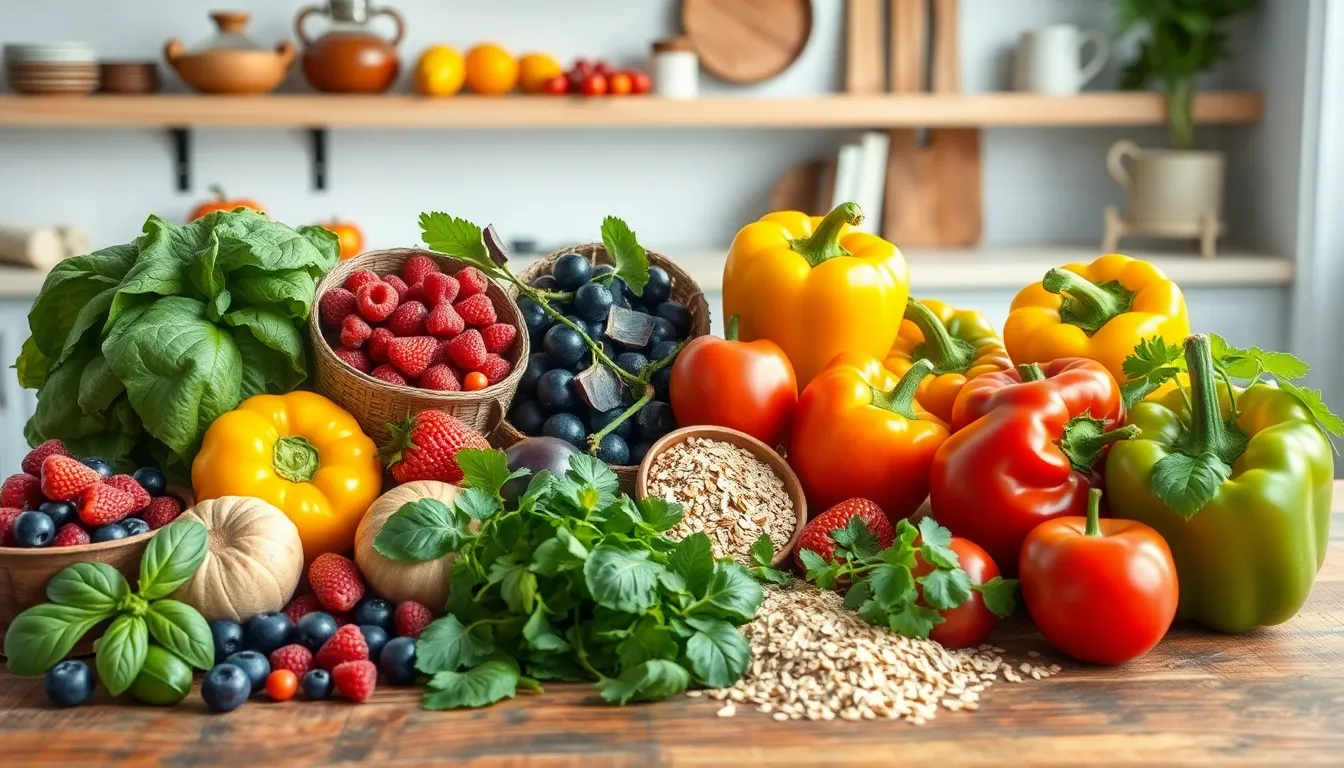In a world where kale has become the new king and quinoa struts around in designer outfits, healthy ingredients are taking center stage. They’re not just the boring friends at the dinner table anymore; they’re the life of the party. Who knew that eating well could be this exciting? From vibrant veggies to power-packed proteins, these ingredients are here to jazz up meals and boost health without sacrificing flavor.
Table of Contents
ToggleOverview Of Healthy Ingredients
Healthy ingredients play a significant role in modern cuisine. Foods like kale, quinoa, and avocados offer vibrant colors and rich flavors. Nutrient-dense options attract health-conscious consumers. Incorporating these ingredients into recipes promotes wellness and enhances taste.
Fresh vegetables, such as spinach, provide essential vitamins and minerals. These greens form the backbone of many dishes, adding both crunch and nutrition. Whole grains, including brown rice, offer fiber and support digestive health. They serve as satisfying bases for meals, complementing various flavors.
Fruits rich in antioxidants, like blueberries and oranges, deliver sweetness alongside health benefits. Their bright hues make meals visually appealing, encouraging consumption. Healthy fats from sources like olive oil and nuts contribute to heart health and flavor depth. These fats elevate dishes, making them irresistible while providing essential fatty acids.
Herbs and spices, including turmeric and garlic, add significant health benefits and enhance flavor profiles. They allow for bold tastes without added calories or sodium. Fermented ingredients, like yogurt and kimchi, improve gut health while offering unique flavors. Their probiotic properties support overall wellness.
Plant-based proteins, such as lentils and chickpeas, provide sustainable options for those seeking alternatives to meat. These ingredients deliver essential nutrients while reducing environmental impact. Superfoods, including chia seeds and spirulina, enrich meals with their concentrated health benefits. Each serves as a powerhouse of nutrients, often requiring only small amounts for a big impact.
Embracing healthy ingredients not only transforms meals but also makes nutrition enjoyable. Chefs and home cooks alike increasingly explore combinations that highlight these nutrient-rich options.
Types Of Healthy Ingredients

Healthy ingredients encompass a range of foods that contribute to nutrition and wellness. They enhance meals with both flavor and health benefits.
Fruits And Vegetables
Fruits and vegetables form the foundation of a healthy diet. Packed with vitamins, minerals, and fiber, these foods support digestion and overall health. Colorful options like berries, spinach, and bell peppers provide antioxidants. Incorporating a variety of these foods ensures a rich intake of nutrients. Eating seasonal produce optimizes flavor and nutrition. Fresh herbs, such as basil and cilantro, add aromatic qualities to dishes. Consuming fruits and vegetables regularly can reduce the risk of chronic diseases.
Whole Grains
Whole grains offer essential nutrients and the benefits of dietary fiber. Foods like oats, brown rice, and quinoa improve digestion and stabilize blood sugar levels. By retaining the bran and germ, these grains provide more vitamins and minerals than refined alternatives. Swapping white bread for whole grain options boosts nutrient intake. Incorporating whole grains into meals can enhance satiety and promote weight management. Other examples include barley and farro, which deliver unique flavors and textures.
Nuts And Seeds
Nuts and seeds deliver healthy fats and protein, enhancing heart health and reducing inflammation. Almonds, walnuts, chia seeds, and flaxseeds are excellent sources of omega-3 fatty acids. These ingredients also contain vital minerals like magnesium and zinc. Snacking on nuts provides sustained energy without blood sugar spikes. Incorporating seeds into smoothies or salads boosts nutrient density. Diverse options allow for experimentation in recipes to create satisfying dishes.
Benefits Of Healthy Ingredients
Healthy ingredients offer numerous advantages that positively impact diet and wellness. Their incorporation into meals enhances nutritional value and flavor.
Nutritional Advantages
Nutrient-rich foods, such as leafy greens and whole grains, deliver essential vitamins, minerals, and fiber. Leafy greens like spinach and kale are high in vitamins A, C, and K, supporting immune function and skin health. Whole grains, including quinoa and brown rice, provide complex carbohydrates that fuel the body while maintaining stable energy levels. Antioxidant-rich fruits, such as berries and citrus, protect against oxidative stress. Healthy fats, derived from nuts and avocados, improve nutrient absorption and promote satiety. Incorporating these ingredients into meals ensures balanced nutrition and aids in achieving dietary goals.
Impact On Overall Health
Regular consumption of healthy ingredients significantly enhances overall health. Fruits and vegetables contribute to reducing chronic disease risk, including heart disease and diabetes. They also support healthy digestion and weight management due to their high fiber content. Whole grains assist in maintaining healthy cholesterol levels, lowering the risk of cardiovascular issues. Healthy fats are crucial for brain function and hormone regulation. Furthermore, plant-based proteins from legumes and tofu support muscle health and offer sustainable nutrition alternatives. Prioritizing these ingredients not only nurtures individual well-being but also fosters a healthier lifestyle.
How To Incorporate Healthy Ingredients In Your Diet
Incorporating healthy ingredients into daily meals can elevate both nutrition and flavor. Understanding how to effectively integrate these foods leads to enjoyable and wholesome dining experiences.
Meal Planning Tips
Prioritize meal planning by choosing a variety of colorful fruits and vegetables to include in each meal. Assign specific days for meal prep to streamline cooking during busy weekdays. Select whole grains such as quinoa or brown rice as bases for lunches and dinners. Incorporate healthy fats from sources like avocados and olive oil throughout the week. Keep a list of nutrient-dense snacks, including nuts and seeds, to promote healthy choices between meals. Ensure that each meal contains a balance of protein, fiber, and healthy fats, making it easier to maintain energy levels and satiety.
Easy Recipes
Create simple recipes highlighting healthy ingredients for quick and nutritious meals. Combine diced avocados, tomatoes, and onions for a fresh guacamole, ideal as a dip or topping. Blend spinach with Greek yogurt, a ripe banana, and a teaspoon of honey for a nutrient-rich smoothie. Roast seasonal vegetables drizzled with olive oil and seasoned with herbs to enjoy a flavorful side dish. Whip up a quinoa salad by mixing cooked quinoa with black beans, corn, cilantro, and lime for a refreshing, protein-packed option. Assemble overnight oats with rolled oats, almond milk, chia seeds, and fresh berries as a quick and healthy breakfast.
Embracing healthy ingredients is more than just a trend; it’s a lifestyle choice that can lead to lasting benefits. By incorporating vibrant fruits, vegetables, whole grains, and healthy fats into daily meals, individuals can enhance their overall well-being. These ingredients not only elevate the flavor of dishes but also support physical health and vitality.
With practical tips and creative recipes at their fingertips, anyone can enjoy the journey of cooking with nutritious foods. This shift towards healthier eating habits encourages a more mindful approach to food, making it easier to maintain a balanced diet. Ultimately, the transformation of healthy ingredients from mundane to exciting opens up a world of culinary possibilities that nourish both body and soul.



